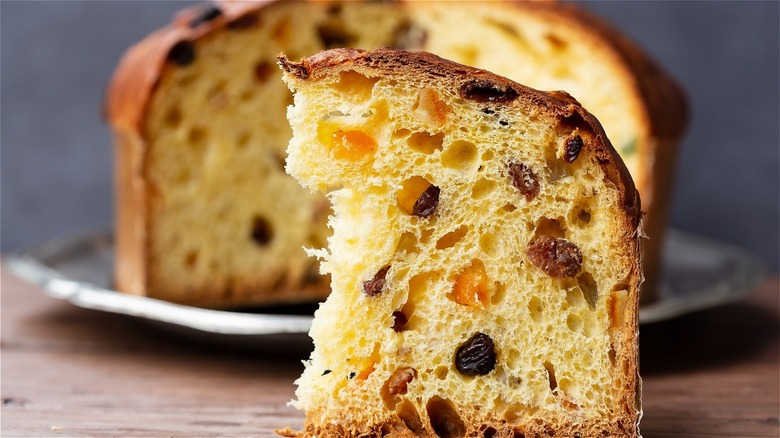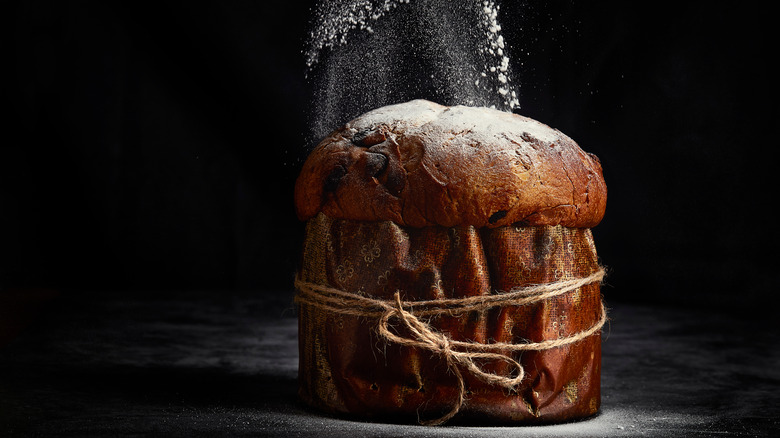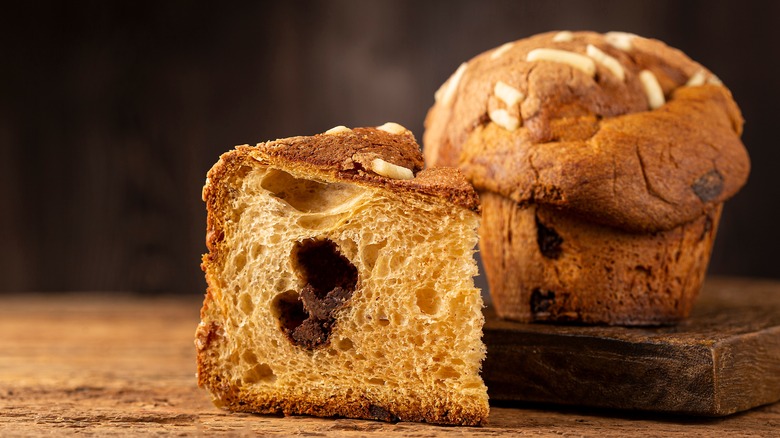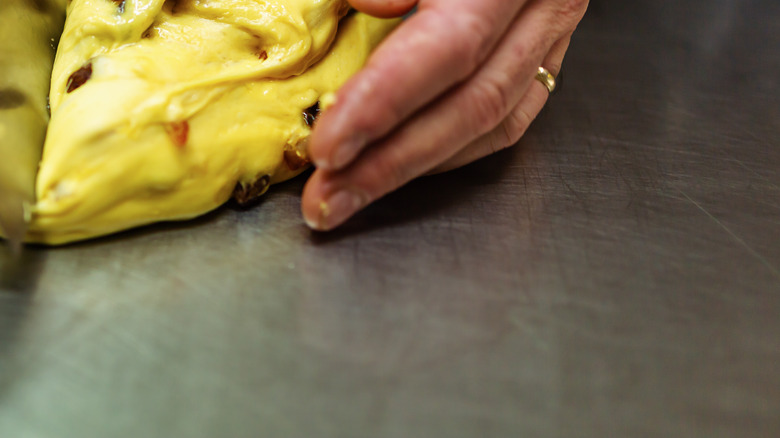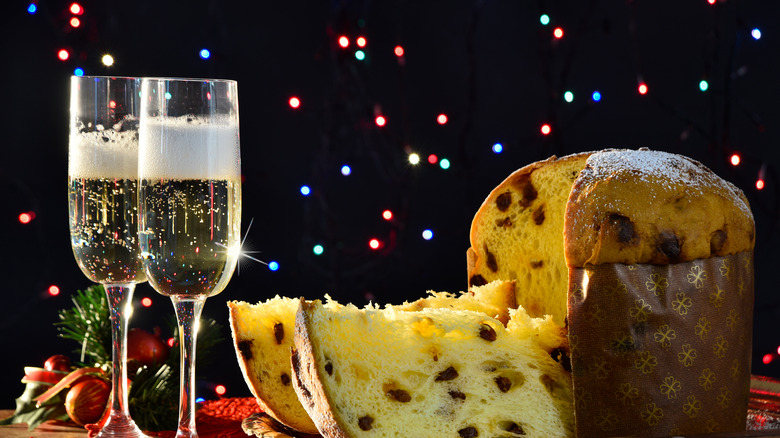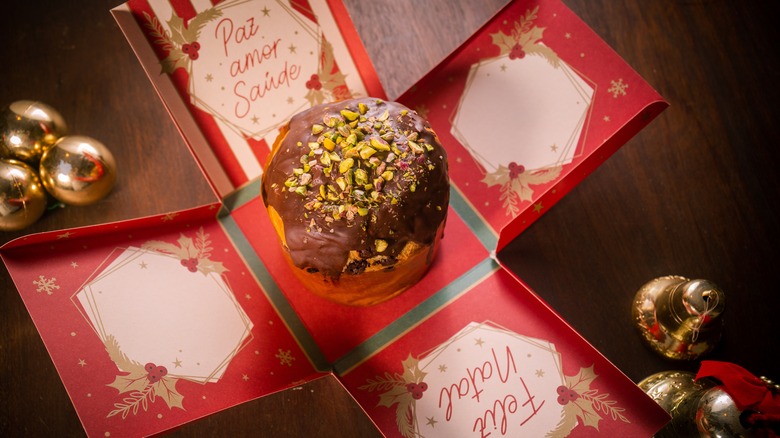What Is Panettone And How Do You Eat It?
We may receive a commission on purchases made from links.
While Americans enjoy the smell of freshly baked sugar and gingerbread cookies, rum-soaked plum cakes, and occasionally even the last slice of pumpkin pie for the year, other countries have their own sweet treats reserved for Christmas celebrations. Germans enjoy a fruit cake called stollen, for instance. Russia dots their krendel bread with pears, apricots, and apples. Mexicans bake a ring-shaped Rosca de Reyes — Three Kings Bread — with candied fruits on top to depict a jewel-studded crown (via Good Housekeeping). And when it comes to Italians, it's the sweet Panettone that they wouldn't fathom celebrating a Christmas without.
Panettone may be fairly easy to find in American supermarkets today (thanks to mass production), but the Christmas bread is said to have originated in Milan centuries ago (via BBC Travel). Although panettone is now deemed as the Italian Christmas bread around the world, and has become a sweet bread that most bakeries all across Italy will sell and which all Italians love, Milan takes great pride in being known as the city that gave birth to the famous panettone.
The author of an Italian book by the name of "Panettone", Stanislao Porzio, told BBC that panettone is an important part of Milan's heritage and that, "An entire city identifies itself with this sweet. It's important for Milan, and for the Milanese." In fact, Porzio has even started a food festival dedicated to panettone that has editions across multiple cities in Italy but mainly takes place in Lombardy, Milan — the rumored birthplace of panettone.
What is panettone?
Pronounced as "pah-net-taw-nee", in simple terms, panettone is an Italian fruit bread (via All Recipes). Panettone usually contains yeast which gives it a raised cylindrical shape with a raised puffy dome on top (via The Spruce Eats). The wheat bread tends to be soft and spongy with a fine, light texture and pockets of air within.
Per La Cucina Italiana, a panettone tends to have a golden exterior with a bright and yellow-colored bread inside that is laden with dried and candied fruits and peels as well as raisins. As soon as you slice into the panettone, a delicious smell of citrus from the fruits and warm bread will fill the air. To put it simply, panettone smells like Christmas.
However, the Italian Christmas treat has been a matter of great debate in Italy. Some believe that because it is chewy and not as sweet as most cakes, panettone classifies as a bread. Others believe that the addition of fruits into the dough and the slight sweetness that it has unlike most breads, warrants panettone to be called a cake. This debate stems from the contentious origin of panettone.
The origin of panettone
According to Smithsonian, panettone was first mentioned in a 1470s manuscript from Milan. Then, the 19th century saw the rise of panettone after it started being mentioned in Milanese cookbooks that projected panettone as a specialty of Milan.
As should be expected of any food item that has such a long and deep history, there are many legends as to how the first panettone was made. "Panettone's" author Porzio claims that panettone in the 15th century was called "pane di tono" which meant, luxury cake and that it was baked for religious purposes (via Insider). Yeast at the time was an important ingredient that needed to be used in the making of Christmas breads and so, was used in the making of panettone which at the time, was considered to be a bread.
Style also reports that panettone in Italian means big bread which signifies the large breads that used to be baked over logs for families to share in the Lombardy region of Milan. As people became wealthier, the more expensive ingredients like dried and candied fruits as well as raisins got added into the dough which turned the panettone bread into a cake.
There are also mentions of a certain baker by the name of Toni who accidentally baked the now-famous panettone — hence "pane di tono" or, the bread of Toni — and that it was he who was responsible for the making of panettone (via Italy Magazine). Panettone also happens to have a love story of its own: a certain boy fell in love with the lowly daughter of a failing bakery owner, whereupon the boy then baked the first panettone in his father-in-law's bakery and won his disapproving family over and got permission to marry the love of his life!
How is panettone made and what does it taste like?
Smithsonian says that the traditional method to make panettone in Italy is very precise. For a baker to be able to call their Christmas bread a panettone, at least 20% of the panettone should be candied fruits and 16% of it should be butter. Any eggs used should have a yolk that makes up for 4% of its composition. Porzio told BBC Travel that up until two decades ago, for every kilo of flour used to make panettone, the traditional recipe called for 400 grams of butter. Today, the flour to butter ratio in most panettone has become 1:1.
Bakers of a proper panettone spend over 36 hours in its making and when done right, the Christmas bread is the best of both worlds: it has the texture of an exquisite bread with the softness of a cake. Style also reports that the traditional panettone gets its flavor only from butter, raisins, candied citrus, and orange peels (panettone is sweet and buttery, of course, but it also famously boasts a citrusy flavor from the candied fruits and raisins used).
Panettone's taste will also vary depending on the kind you've bought — it could have cream, chocolate, and all sorts of flavorings. Style reports that some chefs in Italy even experiment with savory panettone, swapping the raisins for aubergines and pecorino cheese. Plus, what you spread on the panettone will also affect its taste.
How is panettone eaten?
Unlike in the US where the entire affair of eating Christmas bread, cakes, and cookies begins weeks before Christmas Eve, traditionally, Italians used to taste their first bite of panettone at the Christmas Eve dinner on December 24 (via Style). After all the guests were served a slice of the first panettone, one slice would be put away until Christmas the following year to represent continuity (via La Cucina Italiana). Panettone then turned into a breakfast staple for Italians until the end of February.
If you want to eat your panettone as the Italians do, Italy Magazine says to eat a slice with your morning coffee. It's also often eaten as a snack alongside Marsala wine during the day or as a dessert with a glass of sparkling Moscato to finish off the last meal. You could also eat it plain or toasted along with a dollop of cream, butter to jam (via The Spruce Eats).
To serve panettone, the site says to slice it as you would a cake. Whatever you do, make sure to not slice off the top bit of raised dough as the Italians think doing so will bring bad luck. Besides, BBC Travel reports that bakers go through a lot of trouble to make sure that the panettone has a raised puffy top, and they even hang the panettone upside down so that it won't deflate!
Where can you buy panettone?
If you live on the East Coast, you're in for a panettone treat this year. In 2021, New York is hosting its first panettone festival that will see 'Maestri Pasticcieri Italiani' (master bakers) showcase the best of panettone (via Italian Food News). Each chef will have a dedicated booth to sell their Italian Christmas bread from. Per the event page, the second week of the festival will take place from December 16 to 19 with plenty of panettone on sale.
If you can't make it to the panettone festival, Italy-based bakery Olivieri 1882 ships its award-winning panettone — made from a 130-year-old family recipe and free of any preservatives — straight from Italy to your given address anywhere in the U.S. in 48 hours (via Forbes). The Italian bakery has tons of panettone flavors, each priced at $75 and which can be bought from the website (via Olivieri 1882 website).
If you're looking for something more local, both Costco and Aldi also have panettone on their websites, so it might be worth a trip to one. Your local grocery store, depending on the region, might also carry panettone, as well as T.J. Maxx. These options are likely going to be a lot cheaper, too — but considering how precise and time-consuming the traditional methods of making a panettone are, it might be worth the extra cash to shell out on a freshly made panettone from a bakery than a store-bought one. With that in mind, the Washington Post has a helpful list of bakeries that ship freshly baked panettone across the U.S.
